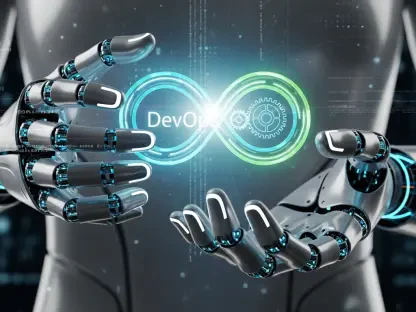Low-code/no-code (LCNC) platforms have revolutionized the way applications are developed, making it easier for non-IT professionals to create sophisticated software solutions. The integration of generative AI (GenAI) into these platforms amplifies their potential, simplifying development processes, and boosting productivity. However, this powerful combination also introduces significant cybersecurity challenges. This article explores the dual impact of GenAI in LCNC environments, highlighting both the opportunities and the risks.
The Rise of Low-Code/No-Code and Generative AI
Simplifying Development with LCNC
Low-code/no-code platforms are designed to simplify software development by enabling users, often called “citizen developers,” to create applications through intuitive interfaces with minimal or no coding. This democratization of software development empowers business professionals to digitally transform processes quickly and efficiently. The visual drag-and-drop tools offered by these platforms accelerate the development cycle, reducing the dependency on traditional IT departments and making it possible to respond swiftly to business needs.
Leveraging the power of generative AI within these platforms further streamlines the development process. GenAI can automate repetitive tasks such as code generation, testing, and deployment. It provides intelligent recommendations that guide developers, ensuring that best practices are followed without requiring deep technical expertise. This synergy between GenAI and LCNC platforms results in a substantial boost in productivity and operational efficiency.
Driving Innovation with GenAI
The impact of GenAI on LCNC platforms goes beyond mere productivity; it fosters a culture of innovation. By automating routine tasks, developers can focus on creative and strategic aspects of app development. GenAI’s ability to analyze data and provide insights facilitates quicker decision-making, enabling organizations to innovate and adapt in a rapidly changing market landscape.
Companies like ServiceNow, Microsoft, and UiPath are leading the charge in integrating GenAI into their LCNC offerings. For instance, Microsoft’s Power Platform leverages GenAI to assist users in building applications, while UiPath’s AI Fabric embeds machine learning models into robotic process automation workflows. These integrations exemplify how GenAI can drive innovation and efficiency across various industries.
Emerging Security Concerns in GenAI-Enhanced LCNC
Data Leakage Risks
While GenAI enhances LCNC platforms, it also introduces considerable security challenges. One major concern is the risk of data leakage. AI bots often require extensive access to sensitive data to function effectively. If improperly configured, these bots can expose confidential information to unauthorized users. This risk is exacerbated by the ease of use and flexibility of LCNC platforms, which might lead to unintentional misconfigurations.
For instance, a financial bot designed to access sensitive financial databases for generating reports could potentially expose this data if its security settings are not meticulously managed. Misconfigurations in LCNC environments can inadvertently expand access far beyond intended internal users, potentially reaching external parties or even being exposed on the internet.
Malicious Data Manipulation
Another cybersecurity challenge is the potential for malicious data manipulation. Bots designed to perform actions based on user inputs can be exploited through techniques such as input manipulation or prompt injection. These attacks can trick AI bots into performing unintended actions. For example, a bot programmed to approve expense reports could be manipulated to approve fraudulent submissions if input parameters are cleverly altered by an adversary.
Such vulnerabilities are particularly concerning in LCNC environments, where the simplicity of development tools may obscure complex security risks. The ease with which citizen developers can create and deploy applications amplifies the potential for such vulnerabilities to be introduced and exploited.
Misconfigurations and Inherent Vulnerabilities
LCNC platforms are known for their user-friendly nature, but this very flexibility can lead to user errors and misconfigurations. The integration of AI-generated code or workflows adds another layer of complexity. AI models might rely on default settings that are not optimized for security, leaving business-critical processes exposed to threats. Furthermore, AI-driven applications often inherit vulnerabilities from the platforms on which they are built.
A notable example is the vulnerability found in Microsoft’s Copilot Studio, where insecure configurations led to Server-Side Request Forgery (SSRF) exploits. This incident highlights the potential risks associated with AI-generated content and the importance of robust security practices in preventing such issues.
Strategies to Mitigate Security Risks
Enhancing Personal Authentication and Authorization
To mitigate the security challenges posed by GenAI in LCNC platforms, strong personal authentication and authorization mechanisms must be implemented. Ensuring that access to corporate data requires personal authentication, rather than relying solely on the bot creator’s permissions, can prevent unauthorized access. This measure ensures that even if a bot becomes publicly available, it cannot access sensitive data on behalf of an unauthorized user.
Aligning Access Permissions
Proper alignment of access permissions is crucial in reducing security risks. The permissions granted to bots must be carefully controlled and limited to the specific actions they need to perform. For instance, a bot accessing a database should only be given permissions to interact with the specific tables relevant to its functions. Over-granting permissions can open up potential attack vectors, increasing the risk.
Real-Time Security Prompts
Incorporating real-time security prompts within LCNC platforms can guide citizen developers to make secure design choices as they build applications. These prompts could include recommendations like encrypting sensitive data fields, setting strong authentication protocols, and flagging any weak or default configurations. Given the user-friendly nature of LCNC platforms, these real-time notifications can serve as an effective educational tool, helping developers to be more aware of potential security pitfalls and how to avoid them.
Continuous Monitoring and Auditing
Implementing continuous monitoring and auditing of AI-enhanced applications is another crucial strategy. Real-time alerts for suspicious activities and automated scans for potential vulnerabilities can provide a proactive defense mechanism, enabling security teams to respond swiftly to any threats. Routine security audits of both the GenAI models and the LCNC platforms should also be conducted to ensure compliance with best security practices.
Embracing the Future of Development
Empowering Citizen Developers with GenAI
The future of application development is set to be deeply influenced by the integration of GenAI into LCNC platforms. This fusion empowers citizen developers, enabling them to drive innovation without needing extensive coding skills. With AI handling repetitive and data-intensive tasks, developers can focus their energies on more strategic and creative endeavors, fostering a culture of rapid innovation and responsiveness to market demands. Organizations can quickly iterate on applications to meet evolving business needs, creating a more dynamic and adaptable digital ecosystem.
Balancing Innovation and Security
However, with these advancements come heightened security challenges that necessitate a careful, proactive approach. Implementing robust security measures, such as stringent authentication protocols, real-time security prompts, and continuous monitoring, is crucial to mitigating the risks associated with GenAI-enhanced LCNC platforms. As organizations embrace this powerful combination, fostering a culture of responsible AI use will be vital in balancing the benefits of innovation with the imperative of maintaining robust cybersecurity.
Conclusion
Low-code/no-code (LCNC) platforms have transformed the landscape of application development, enabling non-IT professionals to craft advanced software solutions with relative ease. The introduction of generative AI (GenAI) into these platforms enhances their capabilities even further, streamlining development processes and significantly increasing productivity. However, this potent synergy brings forth notable cybersecurity concerns. Generative AI can automate and optimize many aspects of development, reducing the time and skill required to create functional software. But as it simplifies tasks, it also introduces vulnerabilities that can be exploited if not properly managed. This article delves into the dual effects of integrating GenAI within LCNC platforms, detailing both the vast opportunities and the inherent risks. The use of these combined technologies presents a compelling way forward for innovation but also necessitates a vigilant approach to security, emphasizing the importance of balancing innovative advancements with robust protective measures.









